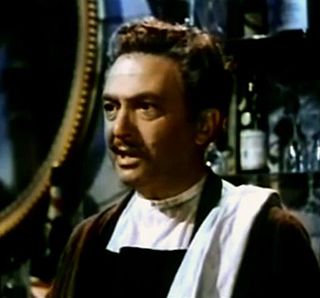
Edwin Eugene Lockhart was a Canadian-American character actor, playwright, singer and lyricist. He appeared in over 300 films, and received an Academy Award nomination for Best Supporting Actor for his role as Regis in Algiers (1938), the American remake of Pepe le Moko.

Marcel Dalio was a French movie actor. He had major roles in two films directed by Jean Renoir, La Grande Illusion (1937) and The Rules of the Game (1939).

Pépé le Moko is a 1937 French film directed by Julien Duvivier starring Jean Gabin, based on a novel of the same name by Henri La Barthe and with sets by Jacques Krauss. An example of the 1930s French movement known as poetic realism, it recounts the trapping of a gangster on the run in Algiers, who believes that he is safe from arrest in the Casbah.

Edmund Breon was a Scottish film and stage actor. He appeared in more than 130 films between 1907 and 1952.

Carlo Ninchi was an Italian film actor. He appeared in more than 120 films between 1931 and 1963.

Pierre Larquey was a French film actor. He appeared in more than 200 films between 1913 and 1962. Born in Cénac, Gironde, France, he died in Maisons-Laffitte at the age of 77.
Gaston Modot was a French actor. For more than 50 years he performed for the cinema working with a number of great French directors.
Joseph Burstyn was a Polish-American film distributor who specialized in the commercial release of foreign-language and American independent film productions.

Gabriel Gabrio was a French stage and film actor whose career began in cinema in the silent film era of the 1920s and spanned more than two decades. Gabrio is possibly best remembered for his roles as Jean Valjean in the 1925 Henri Fescourt-directed adaptation of Victor Hugo's Les Misérables, Cesare Borgia in the 1935 Abel Gance-directed biopic Lucrèce Borgia and as Carlos in the 1937 Julien Duvivier-directed gangster film Pépé le Moko, opposite Jean Gabin.
Philippe Richard was a French film and theater actor.

Saturnin Fabre was a French film actor.

Robert Le Vigan was a French actor.
Fernand Charpin was a French actor. He is known for his role as Honoré Panisse in Marcel Pagnol's Marseille trilogy, beginning with Marius in 1931.

Carlo Montuori was an Italian cinematographer and cameraman.

Arthur L. Mayer was an American film producer and film distributor who worked with Joseph Burstyn in distributing films directed by Roberto Rossellini and other famous European film directors. Some films were distributed under the name Burstyn-Mayer Inc. Mayer was also interviewed by Warren Beatty for Beatty's film Reds (1981).
Line Noro was a French stage and film actress. During the 1930s she played glamorous, often exotic, women in films such as Pépé le Moko. Between 1945 and 1966 Noro was a member of the Comédie Française. She was married to the film director André Berthomieu.
Jules Kruger (1891–1959) was a French cinematographer. He is known particularly for films which he photographed in the 1920s and 1930s for Abel Gance, Marcel L'Herbier, Raymond Bernard, and Julien Duvivier. He also worked in Great Britain and in Spain.
Marguerite Beaugé was a French film editor. Beaugé died in April 1977. Her daughter, Yvonne Martin, was also a renowned film editor.
Robert Seller (1889–1967) was a French stage and film actor.
Jacques Krauss was a French art director. He had a notable influence on the visual look of French poetic realist films before the Second World War, due to his work with Julien Duvivier.











